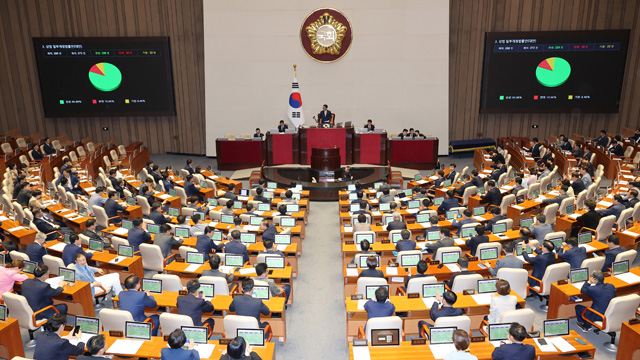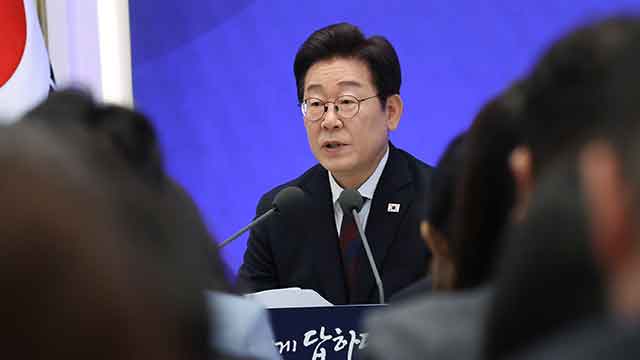LIVING EXPENSES DIFFER AMONG GENERATIONS
입력 2021.09.28 (15:02)
수정 2021.09.28 (16:48)
읽어주기 기능은 크롬기반의
브라우저에서만 사용하실 수 있습니다.
[Anchor Lead]
A Statistics Korea survey shows a stark reality for young and elderly Koreans when it comes to jobs and income sources. Many young people find it difficult to find work despite their job searching efforts. By contrast, elderly people are forced to remain employed even after reaching the retirement age.
[Pkg]
This is how Korean people in their 20s are depicted in recent movies. Faced with the difficulty to find jobs, they choose to live with their parents. A survey conducted by Statistics Korea reveals a similar reality. Asked about where they get living expenses, 39 percent of those in their 20s answered that they received help from parents. Just 54 percent said they earn money on their own or get support from their spouse, not their parents. This is the first census by the agency to study the financial source of young Koreans. It found the exact number of young people belonging to the so-called kangaroo generation, which refers to those who live with and receive financial support from parents. The proportion of unmarried people increased in all age groups. In particular, 43 percent of those in their 30s remained unmarried last year. By contrast, those aged 60 or older tend to live on their own. Twenty-seven percent of them earn living costs by themselves or with the help of their spouses. This is up six percentage points from a decade ago. Only eleven percent answered they receive financial support from their children. It is a big drop from 25 percent in 2010.
[Soundbite] Chung Nam-soo(Statistics Korea) : "This phenomenon occurs, as baby boomers get in their 60s or older. They are relatively financially independent and have enough money for their post-retirement life."
Public pension and government subsidies increasingly replace the decreased help from children. They each account for eleven percent. But one out of five elderly people is categorized as those with limited mobility so they still need caretakers despite their financial independence.
A Statistics Korea survey shows a stark reality for young and elderly Koreans when it comes to jobs and income sources. Many young people find it difficult to find work despite their job searching efforts. By contrast, elderly people are forced to remain employed even after reaching the retirement age.
[Pkg]
This is how Korean people in their 20s are depicted in recent movies. Faced with the difficulty to find jobs, they choose to live with their parents. A survey conducted by Statistics Korea reveals a similar reality. Asked about where they get living expenses, 39 percent of those in their 20s answered that they received help from parents. Just 54 percent said they earn money on their own or get support from their spouse, not their parents. This is the first census by the agency to study the financial source of young Koreans. It found the exact number of young people belonging to the so-called kangaroo generation, which refers to those who live with and receive financial support from parents. The proportion of unmarried people increased in all age groups. In particular, 43 percent of those in their 30s remained unmarried last year. By contrast, those aged 60 or older tend to live on their own. Twenty-seven percent of them earn living costs by themselves or with the help of their spouses. This is up six percentage points from a decade ago. Only eleven percent answered they receive financial support from their children. It is a big drop from 25 percent in 2010.
[Soundbite] Chung Nam-soo(Statistics Korea) : "This phenomenon occurs, as baby boomers get in their 60s or older. They are relatively financially independent and have enough money for their post-retirement life."
Public pension and government subsidies increasingly replace the decreased help from children. They each account for eleven percent. But one out of five elderly people is categorized as those with limited mobility so they still need caretakers despite their financial independence.
■ 제보하기
▷ 카카오톡 : 'KBS제보' 검색, 채널 추가
▷ 전화 : 02-781-1234, 4444
▷ 이메일 : kbs1234@kbs.co.kr
▷ 유튜브, 네이버, 카카오에서도 KBS뉴스를 구독해주세요!
- LIVING EXPENSES DIFFER AMONG GENERATIONS
-
- 입력 2021-09-28 15:02:49
- 수정2021-09-28 16:48:53

[Anchor Lead]
A Statistics Korea survey shows a stark reality for young and elderly Koreans when it comes to jobs and income sources. Many young people find it difficult to find work despite their job searching efforts. By contrast, elderly people are forced to remain employed even after reaching the retirement age.
[Pkg]
This is how Korean people in their 20s are depicted in recent movies. Faced with the difficulty to find jobs, they choose to live with their parents. A survey conducted by Statistics Korea reveals a similar reality. Asked about where they get living expenses, 39 percent of those in their 20s answered that they received help from parents. Just 54 percent said they earn money on their own or get support from their spouse, not their parents. This is the first census by the agency to study the financial source of young Koreans. It found the exact number of young people belonging to the so-called kangaroo generation, which refers to those who live with and receive financial support from parents. The proportion of unmarried people increased in all age groups. In particular, 43 percent of those in their 30s remained unmarried last year. By contrast, those aged 60 or older tend to live on their own. Twenty-seven percent of them earn living costs by themselves or with the help of their spouses. This is up six percentage points from a decade ago. Only eleven percent answered they receive financial support from their children. It is a big drop from 25 percent in 2010.
[Soundbite] Chung Nam-soo(Statistics Korea) : "This phenomenon occurs, as baby boomers get in their 60s or older. They are relatively financially independent and have enough money for their post-retirement life."
Public pension and government subsidies increasingly replace the decreased help from children. They each account for eleven percent. But one out of five elderly people is categorized as those with limited mobility so they still need caretakers despite their financial independence.
A Statistics Korea survey shows a stark reality for young and elderly Koreans when it comes to jobs and income sources. Many young people find it difficult to find work despite their job searching efforts. By contrast, elderly people are forced to remain employed even after reaching the retirement age.
[Pkg]
This is how Korean people in their 20s are depicted in recent movies. Faced with the difficulty to find jobs, they choose to live with their parents. A survey conducted by Statistics Korea reveals a similar reality. Asked about where they get living expenses, 39 percent of those in their 20s answered that they received help from parents. Just 54 percent said they earn money on their own or get support from their spouse, not their parents. This is the first census by the agency to study the financial source of young Koreans. It found the exact number of young people belonging to the so-called kangaroo generation, which refers to those who live with and receive financial support from parents. The proportion of unmarried people increased in all age groups. In particular, 43 percent of those in their 30s remained unmarried last year. By contrast, those aged 60 or older tend to live on their own. Twenty-seven percent of them earn living costs by themselves or with the help of their spouses. This is up six percentage points from a decade ago. Only eleven percent answered they receive financial support from their children. It is a big drop from 25 percent in 2010.
[Soundbite] Chung Nam-soo(Statistics Korea) : "This phenomenon occurs, as baby boomers get in their 60s or older. They are relatively financially independent and have enough money for their post-retirement life."
Public pension and government subsidies increasingly replace the decreased help from children. They each account for eleven percent. But one out of five elderly people is categorized as those with limited mobility so they still need caretakers despite their financial independence.
이 기사가 좋으셨다면
-
좋아요
0
-
응원해요
0
-
후속 원해요
0

















이 기사에 대한 의견을 남겨주세요.